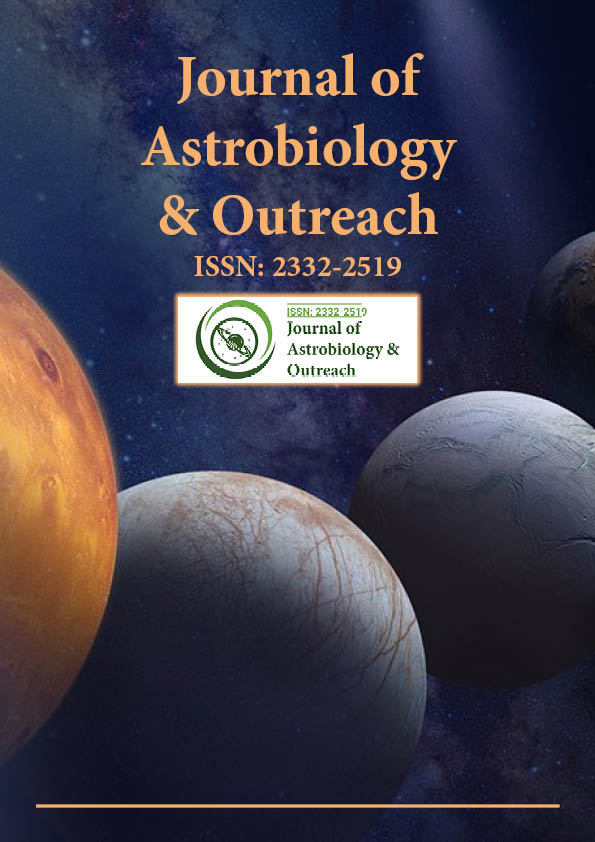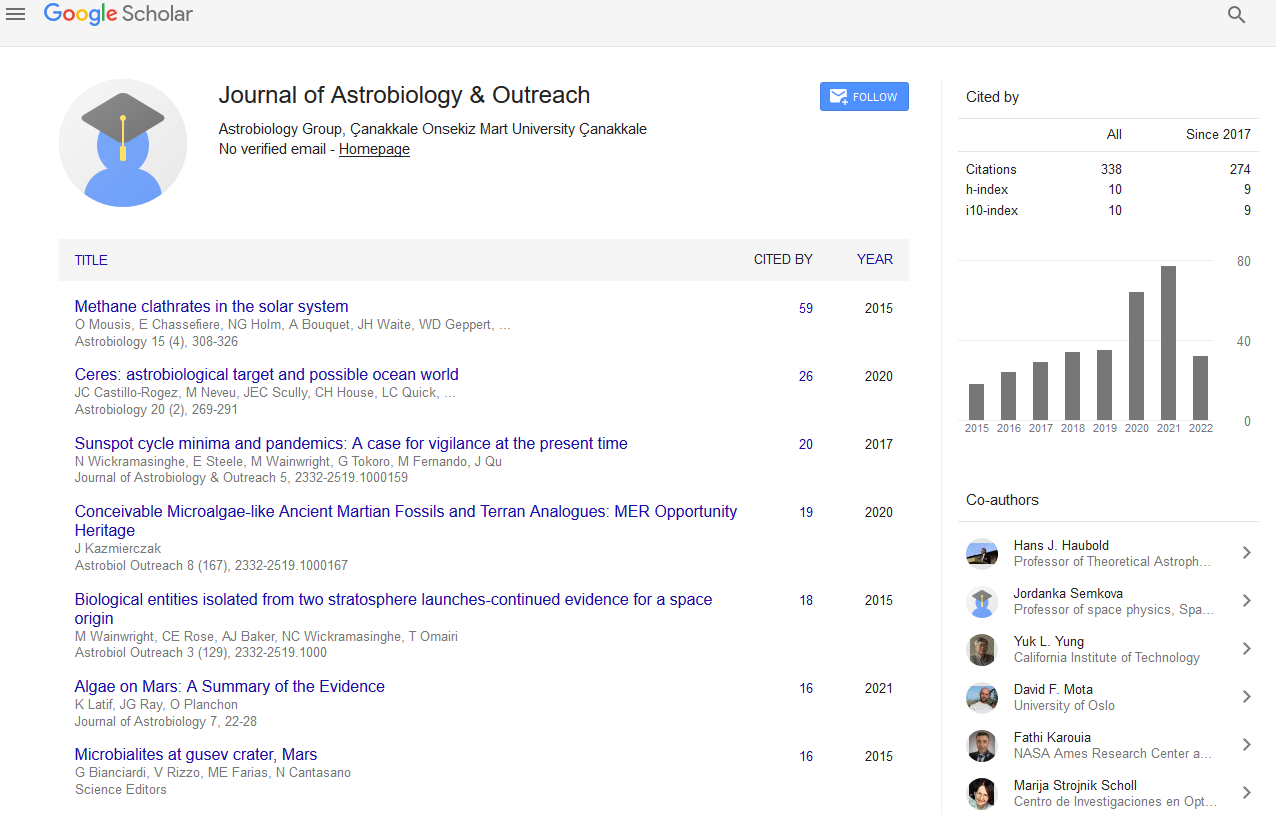Indexed In
- Open J Gate
- Academic Keys
- JournalTOCs
- RefSeek
- Hamdard University
- EBSCO A-Z
- OCLC- WorldCat
- Google Scholar
Useful Links
Share This Page
Journal Flyer

Open Access Journals
- Agri and Aquaculture
- Biochemistry
- Bioinformatics & Systems Biology
- Business & Management
- Chemistry
- Clinical Sciences
- Engineering
- Food & Nutrition
- General Science
- Genetics & Molecular Biology
- Immunology & Microbiology
- Medical Sciences
- Neuroscience & Psychology
- Nursing & Health Care
- Pharmaceutical Sciences
Perspective - (2024) Volume 12, Issue 4
The Role of Ammonia and Oxygen Ices in Planetary and Satellite Atmospheres
Lukas Fischer*Received: 29-Nov-2024, Manuscript No. JAO-24-28013; Editor assigned: 02-Dec-2024, Pre QC No. JAO-24-28013 (PQ); Reviewed: 16-Dec-2024, QC No. JAO-24-28013; Revised: 23-Dec-2024, Manuscript No. JAO-24-28013 (R); Published: 30-Dec-2024, DOI: 10.35248/2332-2519.24.12.365
Description
Understanding the equilibrium vapor pressures of ammonia and oxygen ices at outer solar system temperatures is essential for advancing our knowledge of planetary and satellite atmospheres. These two compounds, ammonia and oxygen, are not only widely distributed in the outer solar system but also play significant roles in forming the chemical and physical properties of the surfaces and atmospheres of icy moons and small planets. The study of their vapor pressures at the extreme temperatures characteristic of the outer solar system provides valuable insights into their stability, phase transitions and interactions with other materials in these cold environments. Given the potential for future exploration of outer solar system bodies such as Europa, Titan and Pluto, these measurements have significant implications for understanding the mechanism of ice-covered planets and their potential to support conditions suitable for life.
Ammonia and oxygen are among the fundamental instable compounds found in the outer solar system. Ammonia ice, for example, is thought to be present on the icy moons of Jupiter and Saturn, such as Europa and Enceladus, as well as on distant Kuiper Belt objects like Pluto. Oxygen ice is similarly found on these bodies, often in conjunction with water ice. The interaction between ammonia and oxygen ices and their respective vapor pressures are essential for understanding surface and atmospheric processes on these moons. The equilibrium vapor pressure of a substance reflects the balance between the solid and gaseous phases at a given temperature, providing insights into sublimation rates, condensation and the stability of these compounds under different environmental conditions.
In the outer solar system, temperatures are exceedingly low, often ranging from 40 K to 100 K, depending on the specific location and distance from the Sun. These extreme conditions cause volatile compounds like ammonia and oxygen to freeze into solid ices, yet they can still undergo phase transitions between solid, liquid and gaseous states, depending on the local environmental conditions. The study of vapor pressures at these temperatures is thus essential for understanding how these compounds interact with their surroundings, including how they contribute to the formation of atmospheres or surface features on icy moons and planets.
For example, on Europa, the surface is composed largely of water ice with a significant presence of ammonia ice mixed in. Ammonia is believed to play an important role in Europa’s surface chemistry and its vapor pressure at extremely low temperatures influences the rate at which ammonia sublimates from the ice into the tenuous atmosphere above. Similarly, oxygen ice on bodies like Europa or Titan also plays a significant role in their atmospheres, even if it is present in trace amounts. The vapor pressure of oxygen ice determines the dynamics of its interaction with surface ices, the potential for oxygen release into the atmosphere and how such gases may contribute to complex chemical processes, including those that could support the existence of life.
Future space missions may also investigate other icy bodies, such as Saturn’s moon Enceladus and Titan, as well as small planets in the Kuiper Belt, such as Pluto and Eris. Each of these bodies presents unique challenges due to the different chemical compositions and environmental conditions found on their surfaces. By understanding the equilibrium vapor pressures of ammonia and oxygen ices, scientists will be able to model the surface and atmospheric processes more accurately. This, in turn, will aid in the search for potential biosignatures or evidence of past or present habitability on these different worlds.
In conclusion, the study of equilibrium vapor pressures of ammonia and oxygen ices at outer solar system temperatures holds immense importance for understanding the behavior of these instable compounds in extremely cold environments. These measurements provide critical insights into the chemical and physical properties of icy moons and different planets, forming our understanding of their surface and atmospheric processes. As space exploration of the outer solar system advances, the ability to model and predict the interactions between these ices and their environments will be essential for revealing the mysteries of these isolated planets.
Citation: Fischer L (2024). The Role of Ammonia and Oxygen Ices in Planetary and Satellite Atmospheres. J Astrobiol Outreach. 12:365.
Copyright: © 2024 Fischer L. This is an open-access article distributed under the terms of the Creative Commons Attribution License, which permits unrestricted use, distribution, and reproduction in any medium, provided the original author and source are credited.

